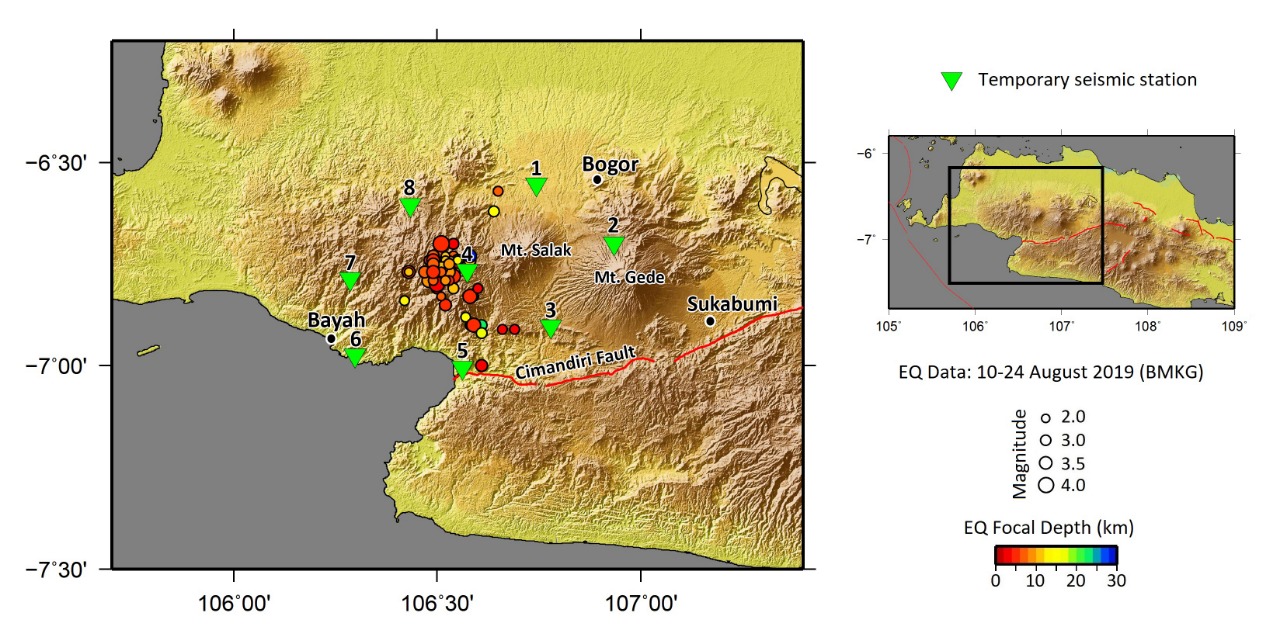ITB Install Seismographs in Bogor to Monitor Seismic Earthquake Swarms
By Adi Permana
Editor Adi Permana

*Installation of Seismographs by Global Geophysics Research Group in Bogor and Pelabuhanratu in Sukabumi. (Photo by: Dr. Zulfakriza)
BOGOR, itb.ac.id – On Friday, 23 August 2019 at 11.10 a.m., District of Bogor was hit by 4.0 magnitude with focal depth of 5 km. According to a report by the Meteorology, Climatology and Geophysics Agency (BMKG), the epicentre is about 101 kilometer to southwest of Bogor district and was felt intensely in Nanggung sub-district. The earthquake was also felt in Sukabumi and Jakarta.
The earthquakes is a series that have begun since 10 August 2019. BMKG issued releases about more than 76 earthquake occurrences around Mount Halimun Salak National Park with magnitudes around 2-4 and hypocenter less than 10 km.
As a response, ITB’s Global Geophysics Research Group, LPPM-ITB, and Center of Excellence for Earthquake Sciences and Technology conducted installations of 8 seismometers on Friday (23/8/2019) around the national park. The installation was conducted in coordination with BMKG of Bandung.
Swarm Earthquake
From seismology’s perspective, the series of earthquakes occurred in Bogor is earthquake swarm. This statement is based on the high and swarming seismic intensity within a cluster as well as the relatively low power of the earthquake which makes difficult detection to the main earthquake.
Seismology considers several things in order to comprehend this earthquake swarm phenomenon. First, the hypocenter pattern to determine the trigger source; second, the earthquake source mechanism; and third, the pattern of pressure strain that happened due to a series of earthquake swarm in Bogor.
According to Prof. Nanang T. Puspito as the Head of Global Geophysic Research Group, installation of these 8 seismographs is part of responsibility of seismology in order to better comprehend the earthquake occurred in Bogor District. “Hopefully it can give information to local government of Bogor District and Provincial Government of West java in the effort to mitigate and reduce earthquake risk,” said Prof. Nanang.
On Friday morning (23/8/2019), team from Global Geophysics Research Group departed to Bogor, Sukabumi, and Pelabuhanratu. Dr. Zulfakria as team leader departed with three other members, namely Ade Surya Putra, M. Randy Caesario Harsuko, and Yopi Apryan Fadilah.
*The spread of earthquake occurrences in Mount Halimun Salak National Park marked with red dots, while the location of seismographs marked with green triangle. (Foto by: Br. Zulfakriza).
In order to hasten the installation, the team is divided in two. The North Team focused on installation in Sukabumi, Citeko, and Bogor, while the South Team focused on installation in Pelabuhanratu and west of Mount Salak’ feet.
According to Andri Dian Nugraha as the Head of Geophysics Program Study of master and doctor programs, the monitoring was conducted for 30 days by using local network and spread over the location of earthquake swarm. “After 30 days, the team will identify event and determine the hypocenter. Hopefully no major earthquake occurred during the earthquake swarm in Bogor,” said Dr. Andri.

.jpg)
.jpg)
.jpg)
.jpg)
.jpg)

